
The autumn of 2022 was one of those amazing years for fall color. 2023 has been fairly good as well, which I was not expecting, given the severe drought that can cause woody plants to defoliate earlier than usual. But in 2022, even some woody plants that I don’t normally see great fall color on looked spectacular. Fall color is influenced by a variety of factors including species genetics, cooling temperatures, shorter days, sunny days and the process of chlorophyll degrading in fall. Throughout autumn, plants are breaking down chlorophyll and sending carbohydrates to the roots. As chlorophyll levels decline, other fall color pigments become visible. The two types of pigments that give leaves their bright autumn colors: carotenoids and anthocyanins.
Carotenoids produce bright yellow colors. They are present during the growing season, but only become visible when chlorophyll levels drop in fall. They protect leaves from harmful compounds that are normal by-products of photosynthesis. Without carotenoids, leaf photosynthetic components would disintegrate. Anthocyanins produce red, orange, and pink hues. Unlike the carotenoids, anthocyanins are made by plants midway through the autumn disassembly to help shade leaf photosynthetic systems in fall since leaves undergoing component disassembly in fall are more susceptible to damage from bright light, especially as temperatures cool. Plants with little fall color are usually more resistant to this damage need to produce red pigments. The shading function of the red pigments explains why leaves exposed to direct sunlight are the brightest red, while leaves shaded within the canopy of a plant often show little or no accumulation of these pigments. Learn more about this process.
So, what are some great woody plants for fall color? Our Extension Woody Ornamentals Specialist Dr. Laura Jull has written a great publication called ‘Selecting Woody Landscape Plants for Fall Color: An Illustrated Guide‘, that is a wonderful resource for plant selection.
Here are some of my favorite plants for fall color from the Dane County Extension Teaching Garden and my home garden.
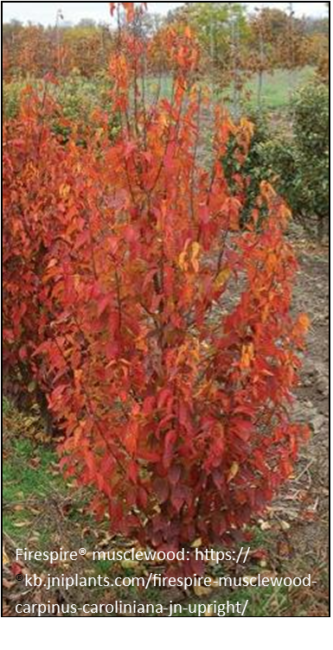
There are plenty of maple species that have excellent fall color, but maples are over-planted, and when the tree palette is not diverse enough, and you have a pest like emerald ash borer go through, an overplanted species that is killed (like ash) can create a huge effect loss of tree canopy. One native non-maple tree with great fall color is musclewood, Carpinus caroliniana. This is a smaller scale tree that can take partial shade; it is found as an understory or forest edge plant, but will take full sun if the soil has decent moisture. It has amazing sinewy bark from which it gets its common name, and delicate seed pods that remind me of origami or Christmas tree ornaments. A Wisconsin breeder named Mike Yanny has made a few nativar selections (selections made from native seed stock), one of which is called Firespire®. It is a narrow, smaller scale tree with great coppery red fall color. We have both this nativar and the straight species tree with wonderful muscled bark in the Teaching Garden.
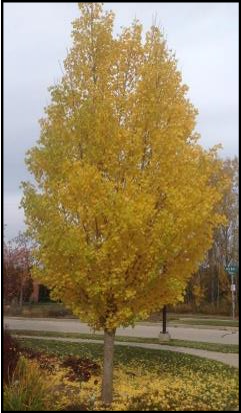

A tough non-native tree for sun with amazing fall color is ginkgo, Ginkgo biloba. This is an ancient tree species with amazing fan-shaped leaves has reliably brilliant yellow fall color. Ginkgoes have an interesting characteristic with their leaves: ‘synchronized leaf drop’, which results in a ‘ginkgo rain’ of nearly all the leaves dropping at once when there is a freeze or frost. This sure can save time with raking! This cultivar (cultivar= cultivated variety) at the Teaching Garden is called ‘Presidential Gold’.
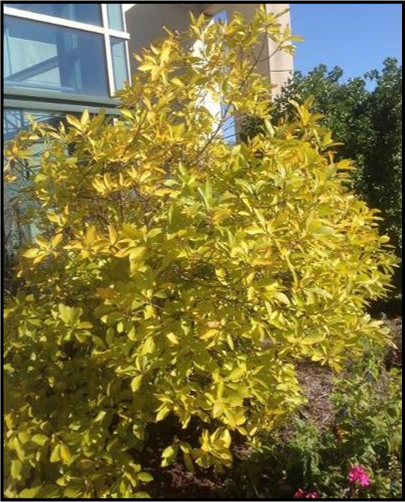
The Eastern fringetree, Chionanthus virginicus, is a US native (but not a Midwest native) turns a nice consistent bright gold in fall. It gets masses of lightly fragrant white, confetti-like flowers in spring and if a female (with a male pollinator around) also bears dark blue berries. This one is in the Dane County Extension Teaching Garden near the front door of the building. It needs sun and decent soil moisture for good performance. Here it is in fall color.
Bottlebrush buckeye, Aesculus parviflora, is another southeastern US native that performs very well here and is hardy to Zone 4. As it’s name suggests, it has large bottle-brush –like white flowers in late spring. Some years the fall color is better than others. It will take part shade, but prefers more sun and gets better fall color there. This one in the Teaching Garden is the dwarf cultivar ‘Rogers’ but will still get about 8-10’ tall and it does sucker.
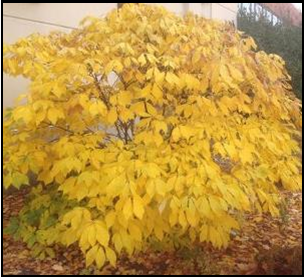
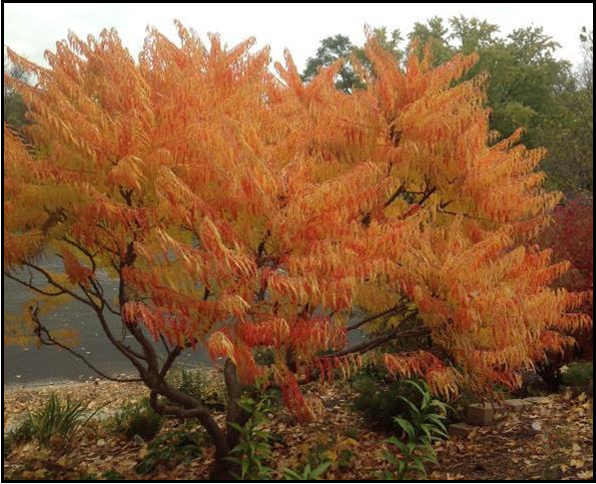
Tiger Eyes® Staghorn Sumac is a selection of our native staghorn sumac that has gold fine-textured foliage in spring that turns chartreuse over summer. It does not sucker as aggressively as the straight species, but contrary to advertising it does sucker some (and throws up shoots some distance from the parent) so you have to keep an eye out for those. This one is in my yard and is about 13 years old. It is starting to die out, but is still robust and about 10 feet tall. Sumacs have a coarse texture in winter, but I have pruned this one carefully so it has an attractive architecture. Sumacs are not terribly fussy about soil types but do best in medium moisture and get the best fall color in full sun. Mine is getting shaded by the neighbor’s maple, so it is less bright than it once was.
A vine with great fall color is Boston Ivy ‘Fenway Park’. During the growing season it is yellow in full sun settings and light chartreuse in part shade situations. This one is growing on an east-facing wall at the Dane County Extension Teaching Garden. Boston ivy does need a wall surface to cling to with its ‘sucker feet’ called ‘holdfasts’. Don’t use on brick walls.
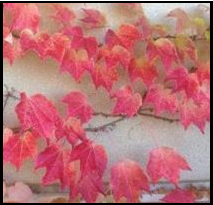
There are many more plants with great fall color including some perennials. Going into winter, it is so nice to have the garden gets one last ‘hurrah’ with brilliant fall color, and you too, can have a bright fall landscape. You can also visit the Teaching Garden at Dane County Extension on Madison’s east side (5201 Fen Oak Drive) to see some of this great fall foliage yourself!




